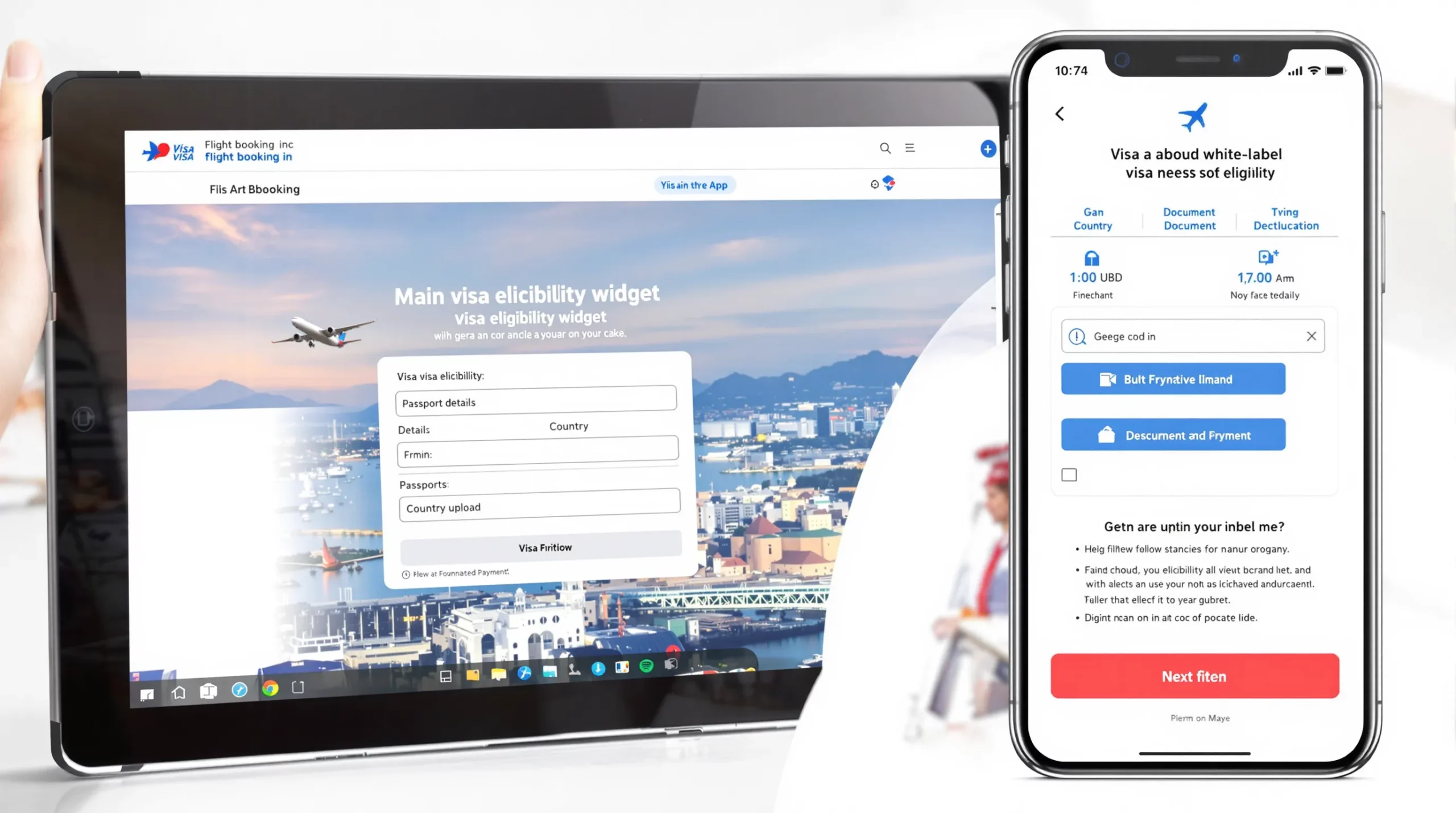API vs. White-Label App: Which Visa Integration Model Suits You?

Turn Visa Complexity Into Competitive Advantage
The average traveler abandons 38% of international trips because visa rules look too confusing (IATA 2024 Passenger Insights Report). If you sell flights, tours, or accommodation across borders, turning that pain point into a friction-free service is a proven way to boost conversions and earn extra revenue.
Most travel brands that add visa assistance follow one of two paths:
- Integrate a Visa API directly into the booking flow
- Launch a fully hosted, white-label visa application app
Both approaches are available from the SimpleVisa platform. The real question is which model fits your product roadmap, technical bandwidth, and commercial goals. Let’s break down the trade-offs so you can make an informed decision.
Visa API vs. White-Label App at a Glance
| Criteria | API Integration | White-Label App |
|---|---|---|
| Time-to-market | 2–8 weeks (depending on depth of UX work) | 3–5 days (DNS + branding) |
| Engineering resources | Requires front-end & back-end devs | No-code. Simple embed or referral link |
| User experience | 100% inside your existing booking flow | Hosted microsite with your logo & colors |
| Data ownership | Full visibility of traveler data via API | Access to dashboards & exports |
| Upsell opportunities | Cross-sell visas alongside seats, bags, insurance in one cart | Earn commission on each completed application |
| Ongoing maintenance | Handle API versioning & UX tweaks | SimpleVisa maintains infrastructure & compliance |
| Best for | OTAs, airlines, super-apps with in-house tech teams | Small–mid travel agencies, TMCs, consortia |

When an API Integration Is the Better Choice
-
You have a capable dev team and agile sprints planned. If you push weekly releases, adding a RESTful visa API call inside your checkout is straightforward. Developers can surface eligibility results in <500 ms, then post traveler data back to SimpleVisa for processing.
-
You want total control over UX and merchandising. Airlines often show a dynamic banner—“Need a visa for India? Add it now for $39”—on the ancillaries page. With the API you decide where and how to prompt, bundle, discount, or A/B test.
-
You operate multiple channels. An API lets you reuse the same backend for your web, mobile, call-center, and kiosk applications without duplicating logic.
-
Compliance teams require data residency. Because API responses are JSON, you can store traveler data in your AWS or Azure region before forwarding the payload to SimpleVisa’s processing endpoint.
-
Road-map scalability matters. Need to layer carbon calculators or duty-of-care services later? APIs give you lego blocks to expand your platform.
Internal read: For a deeper dive into the technical flow, see our post How eVisa APIs work: Step by Step.
Example: GlobeJet Airlines
GlobeJet’s product team embedded SimpleVisa’s /eligibility endpoint on the passenger details page. Travelers whose nationality required an eVisa saw a checkout toggle:
- Add India eVisa – $52 (average approval 48 h)
Uptake reached 14% within the first month, generating $6.80 in ancillary margin per booking—outperforming seat selection in certain markets.
When a White-Label Visa App Makes More Sense
-
Speed is critical. Trade shows start next quarter and you need a solution yesterday. A white-label app can be live under
visas.yourbrand.comby the end of the week. -
You don’t control your core booking engine. Many travel consortia and franchise agencies rely on third-party GDS front ends. Adding new UI components is either impossible or cost-prohibitive.
-
Support teams prefer a turnkey workflow. SimpleVisa handles KYC checks, document compression, multilingual help texts, and 24/7 traveler chat. Your staff only see status dashboards and commission reports.
-
Marketing wants a shareable asset. Agents can email or WhatsApp a branded link—“Apply for your Vietnam visa here”—and track conversions without touching code.
-
Risk mitigation. Hosting under SimpleVisa’s PCI-DSS compliant environment avoids any payment-processing scope for your IT auditors.

Example: WanderNow OTA
With only one full-stack developer, WanderNow opted for the white-label route. The team uploaded their logo, chose brand colors, and pointed a sub-domain to SimpleVisa’s app. Average implementation time: 4 hours. Six months later, 21% of outbound passengers start their visa through the portal, producing an incremental $120K in annual revenue with virtually zero overhead.
Five Questions to Guide Your Decision
- How many engineering hours can you realistically allocate this quarter?
- Do you want the visa offer inside the booking path or as a post-purchase upsell?
- Who will handle traveler support tickets and re-submission requests?
- Is data residency or PCI scope a blocker for your compliance team?
- Which KPI matters most—speed to launch, brand consistency, or profit per booking?
Map your answers to the comparison table above. If three or more answers favor control and customization, lean API. If speed and simplicity score higher, white-label is your friend.
Implementation Timeline & Costs
-
API Starter Pack
- Sandbox keys in 24 h
- Swagger docs & Postman collection
- Dedicated solutions engineer
- Usage-based pricing: pay per processed application
-
White-Label Launch Pack
- Brand kit & DNS configuration
- Preloaded visa knowledge base for 200+ destinations
- Commission revenue split
- No setup fee for the first domain
Both options include access to SimpleVisa’s 99.9% SLA visa management platform, a 92% average approval rate, and automated traveler notifications.
Future-Proofing Your Choice
The good news: you don’t have to marry one model forever. Many partners start on white-label to validate demand, then graduate to the API once ROI is proven and sprint capacity frees up. SimpleVisa supports hybrid setups so you can mix and match by market or brand.
Frequently Asked Questions (FAQ)
Is the visa content updated automatically?
Yes. Whether you choose API or white-label, SimpleVisa syncs with government sources daily and pushes real-time rule changes.
Can I localize the experience in multiple languages?
API responses include translation tokens. The white-label app ships with 12 languages and community-powered updates.
What about payment settlement?
For API users, you can collect the fee yourself and remit a net amount to SimpleVisa, or redirect to our PCI gateway. The white-label app handles payments end-to-end and credits your commission monthly.
Does SimpleVisa support group or corporate bookings?
Yes. Batch endpoints and CSV upload are available via API, while the white-label dashboard offers a group wizard.
How soon can I switch from white-label to API?
Anytime. Your account manager will issue production keys and migrate existing traveler records seamlessly.
Choose Your Path—And Start Earning From Visas
Ready to remove border hassles and unlock ancillary revenue? Whether you embed our Visa API or launch a White-Label App, SimpleVisa gives you the tools to make travel simple.
👉 Book a 15-minute demo to see both models in action: https://simplevisa.com/demo